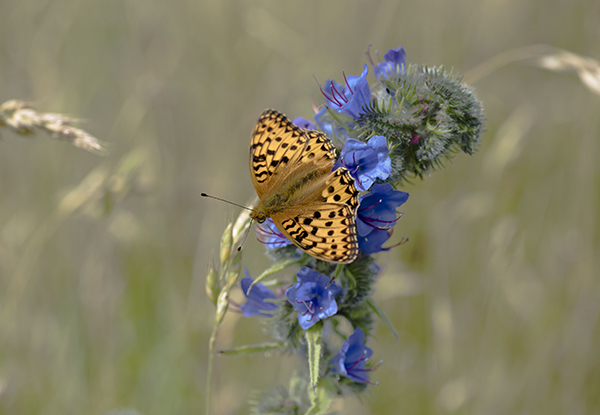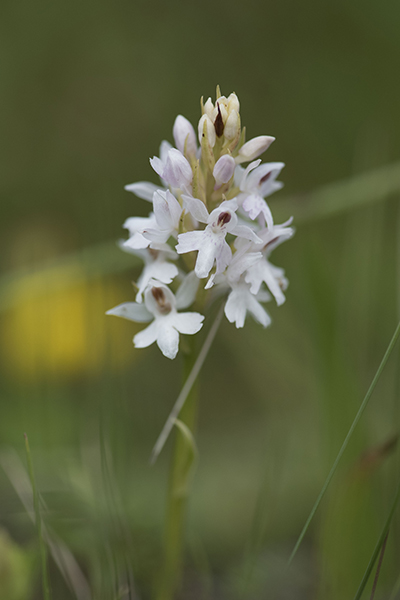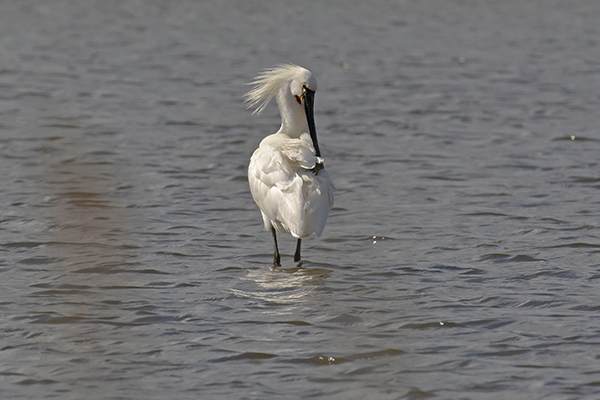Even as we pulled up into the car park it became obvious this was a very special place. Bee orchids and Pyramidal Orchids could be seen even before we'd stopped moving!
Sean knows his stuff and as we made our way down towards the dune slacks he pointed out numerous hybrids, which I struggled to get my head round, as gems such as the salmon pink Early Marsh Orchid and its stunningly beautiful sub-species coccinea, presumably named after the coccineal red food dye.
Whilst inspecting these specimens I noticed a bee on on Southern Marsh Orchid with an old orchid pollinia stuck ti it. Proof, if it was needed that, successful sexual reproduction of this species takes place on this site.
Both Southern & Northern Marsh Orchids can be found on this site and Sean was using a colour chart to try and determine if the colour can be used to separate these and some of the hybrids.
By now the sun was breaking through and the drizzle that greeted our arrival had abated. Butterflies distracted us from the orchids with Common Blue and Dark Green Fritillary both on the wing. The fritillary settling on brilliant blue Vipers Bugloss made for a fantastic photo oppurtunity whilst the Common Blue on its Birdsfoot Trefoil food plant gave an opportunity to try the macro lens out.
Distractions over we concentrated on the task in hand and started searching the dune slacks for the diminutive and rare Fen Orchid. Once we got our eye in and were in the right area they were everywhere and what a delight they were.
As well as the Fens the dune slacks held good numbers of Dune Helleborine and Common Twayblade. The Dune Helleborines were just about coming into flower and in another week they'll be out in all their glory.
Marsh Helleborines above and Common Twayblade below:
Common Spotted orchids weren't the commonest species of Orchid here but were present and showed a variety of colours ranging from the normal pink to almost pure white.
Working our way to the coast we looked out for the nationally rare Sea Astor and discovered a group of the parasitic Broomrape - what species we didn't determine.
On the way back to the car we stopped to look for Green-flowered & Narrow -lipped Helleborine. We found both but unfortunately they weren't yet in flower.
Narrow-lipped Helleborine above and Green-flowered Helleborine below, yeah I know.....
After a very late lunch we headed back up to Gloucestershire and a real treat. The parasitic Birdsnest Orchid in its classic heavily shaded Beech woodland habitat at Birdlip. Completely lacking chlorophyll they rely on digesting living fungi for nutrition which grow within the plant! the fungi in turn gets its nutrition from a symbiotic ectomycorrhizal relationship with its Beech host. The tree photosynthesises and produces carbohydrates that the fungi rely on - the orchid taps into this relationship and obtains its nutrition from the fungi! Not only is it a beautiful plant but its lifestyle is fascinating.
For me this was the orchid of the trip but we still had time for one more stop - Barrow Wake watchpoint for the tiny Musk Orchid. I'd been to this site once before as a biology undergraduate at Manchester University on a field trip to nearby Woodchester valley. Unfortunately we only found one tiny Musk Orchid that wasn't yet in flower.
Arriving at Sean's place I picked up my cart and headed home after a superb day orchid hunting. In total we saw 15 different species. A great trip and many thanks to Sean for arranging it.



































































































